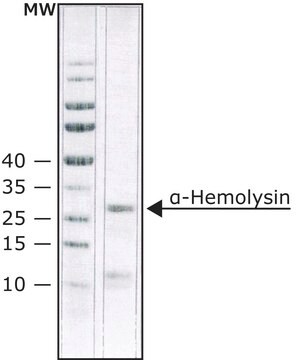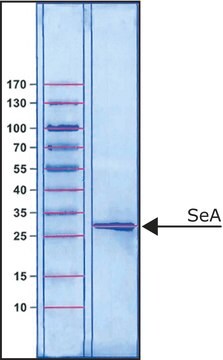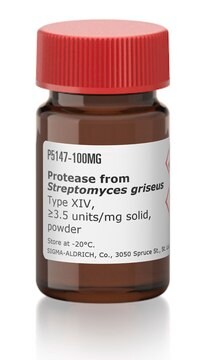About This Item
Polecane produkty
pochodzenie biologiczne
Clostridium tetani E88
masa cząsteczkowa
55 kDa
Zastosowanie
cell analysis
temp. przechowywania
2-8°C
informacje o genach
Clostridium tetani E88 ... CTC01888(1060232)
Opis ogólny
Hemolytic activity of tetanolysin is determined using 2.5% rabbit red blood cells at 37 °C for 40 min.
Zastosowanie
Tetanolysin has been used to analyze the formation of lytic pores in red blood cells (RBCs)1. It has also been used to permeabilize infected RBCs2.
Działania biochem./fizjol.
Cholesterol-binding toxin used to permeabilize cellular membranes to enhance the entry of macromolecules into the interior of the cell. Pores induced reported to be in the range of 20-50 nm.
Uwaga dotycząca przygotowania
Prepared by a modification of the method of Haque, et al.
Rekonstytucja
When reconstituted with 100 μl of sterile water the concentration is 1 μg/μl in 40 mM sodium phosphate buffer, pH 7.2, containing 200 mM NaCl.
Komentarz do analizy
Single band by SDS-PAGE.
This page may contain text that has been machine translated.
Kod klasy składowania
11 - Combustible Solids
Klasa zagrożenia wodnego (WGK)
WGK 3
Temperatura zapłonu (°F)
Not applicable
Temperatura zapłonu (°C)
Not applicable
Środki ochrony indywidualnej
Eyeshields, Gloves, type N95 (US)
Certyfikaty analizy (CoA)
Poszukaj Certyfikaty analizy (CoA), wpisując numer partii/serii produktów. Numery serii i partii można znaleźć na etykiecie produktu po słowach „seria” lub „partia”.
Masz już ten produkt?
Dokumenty związane z niedawno zakupionymi produktami zostały zamieszczone w Bibliotece dokumentów.
Hayley E Bullen et al.
The Journal of biological chemistry, 287(11), 7871-7884 (2012-01-19)
To survive within its host erythrocyte, Plasmodium falciparum must export hundreds of proteins across both its parasite plasma membrane and surrounding parasitophorous vacuole membrane, most of which are likely to use a protein complex known as PTEX (Plasmodium translocon of
Jason W Rosch et al.
The Journal of clinical investigation, 120(2), 627-635 (2010-01-23)
Sickle cell disease (SCD) is characterized by intravascular hemolysis and inflammation coupled to a 400-fold greater incidence of invasive pneumococcal infection resulting in fulminant, lethal pneumococcal sepsis. Mechanistically, invasive infection is facilitated by a proinflammatory state that enhances receptor-mediated endocytosis
Nasz zespół naukowców ma doświadczenie we wszystkich obszarach badań, w tym w naukach przyrodniczych, materiałoznawstwie, syntezie chemicznej, chromatografii, analityce i wielu innych dziedzinach.
Skontaktuj się z zespołem ds. pomocy technicznej








